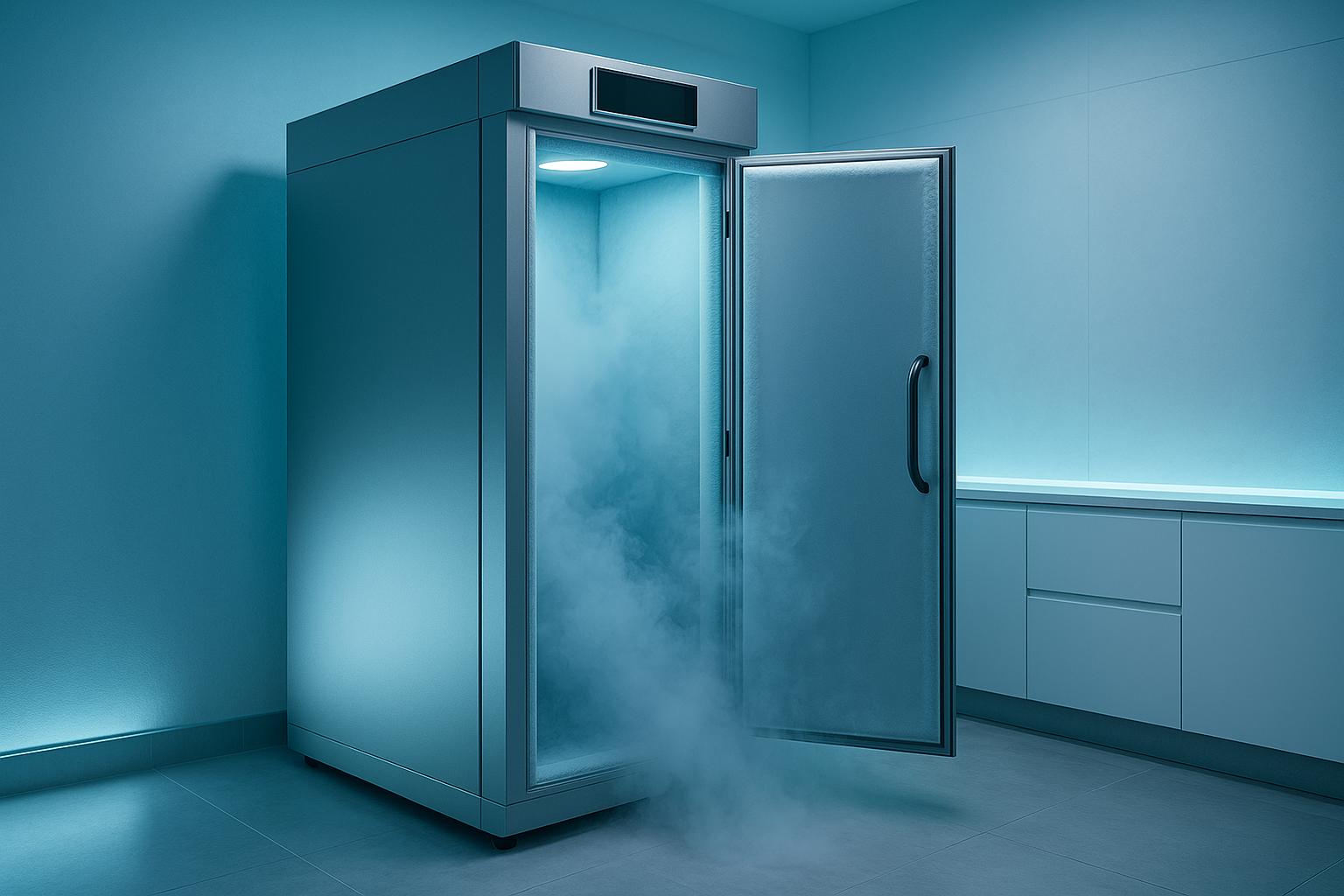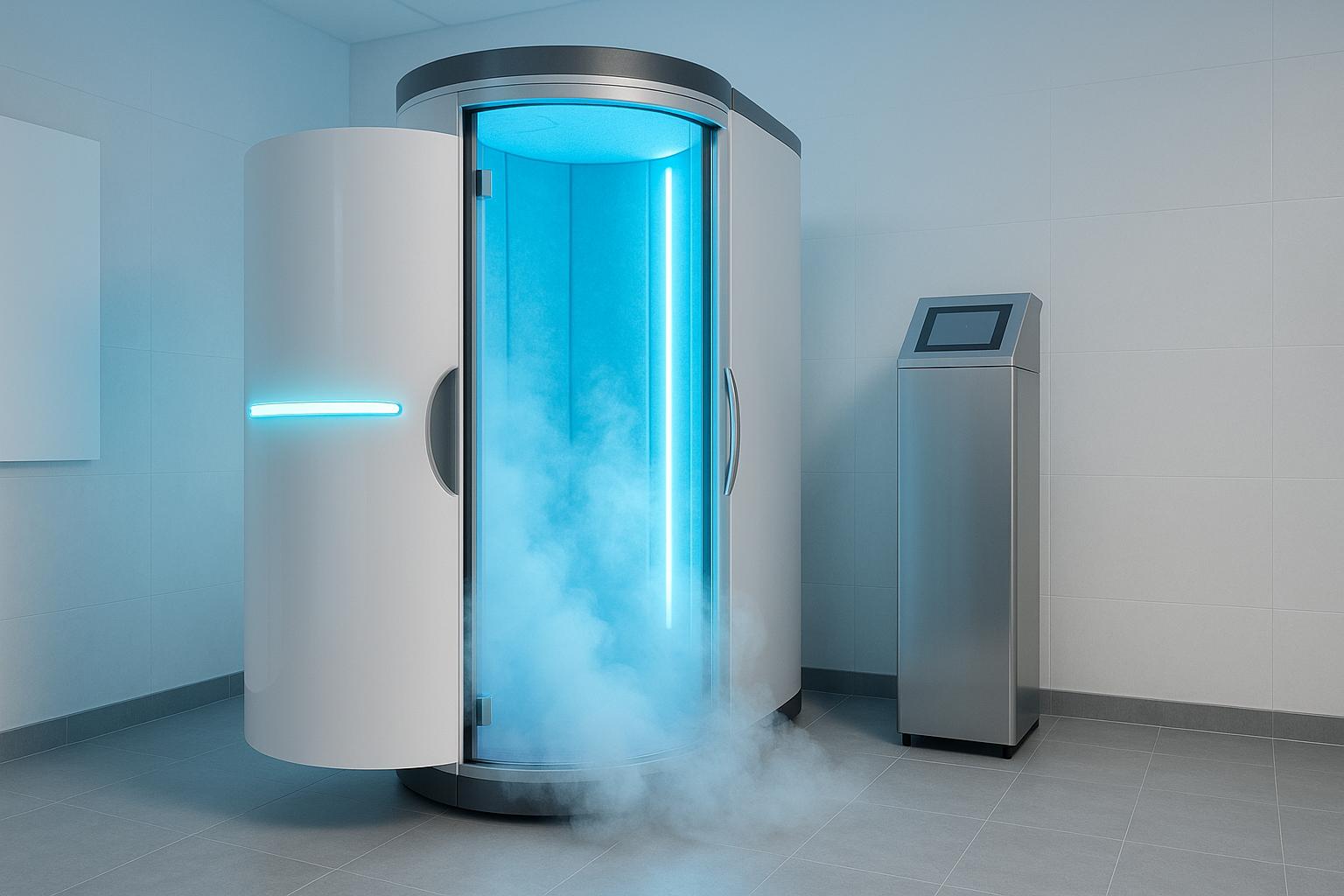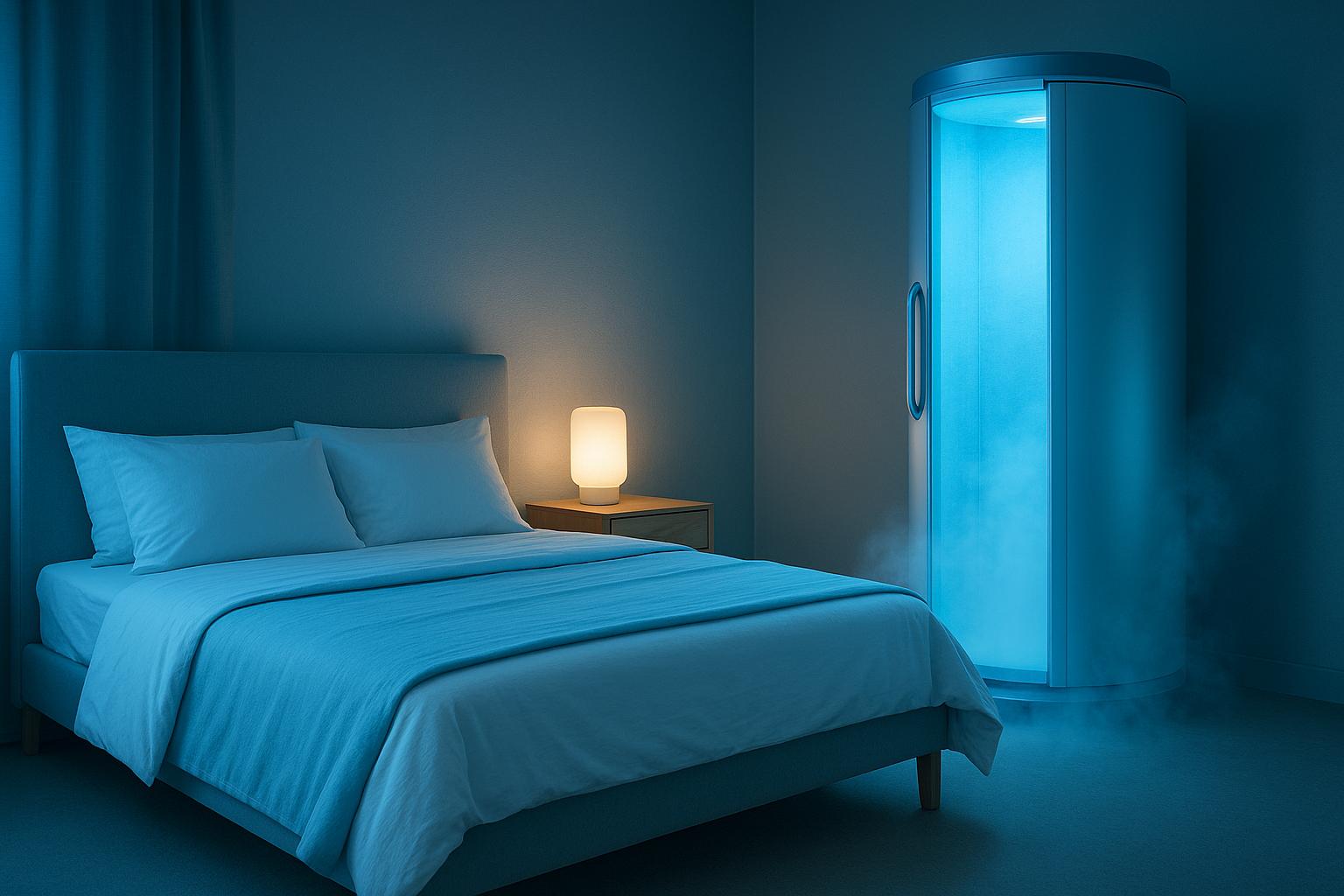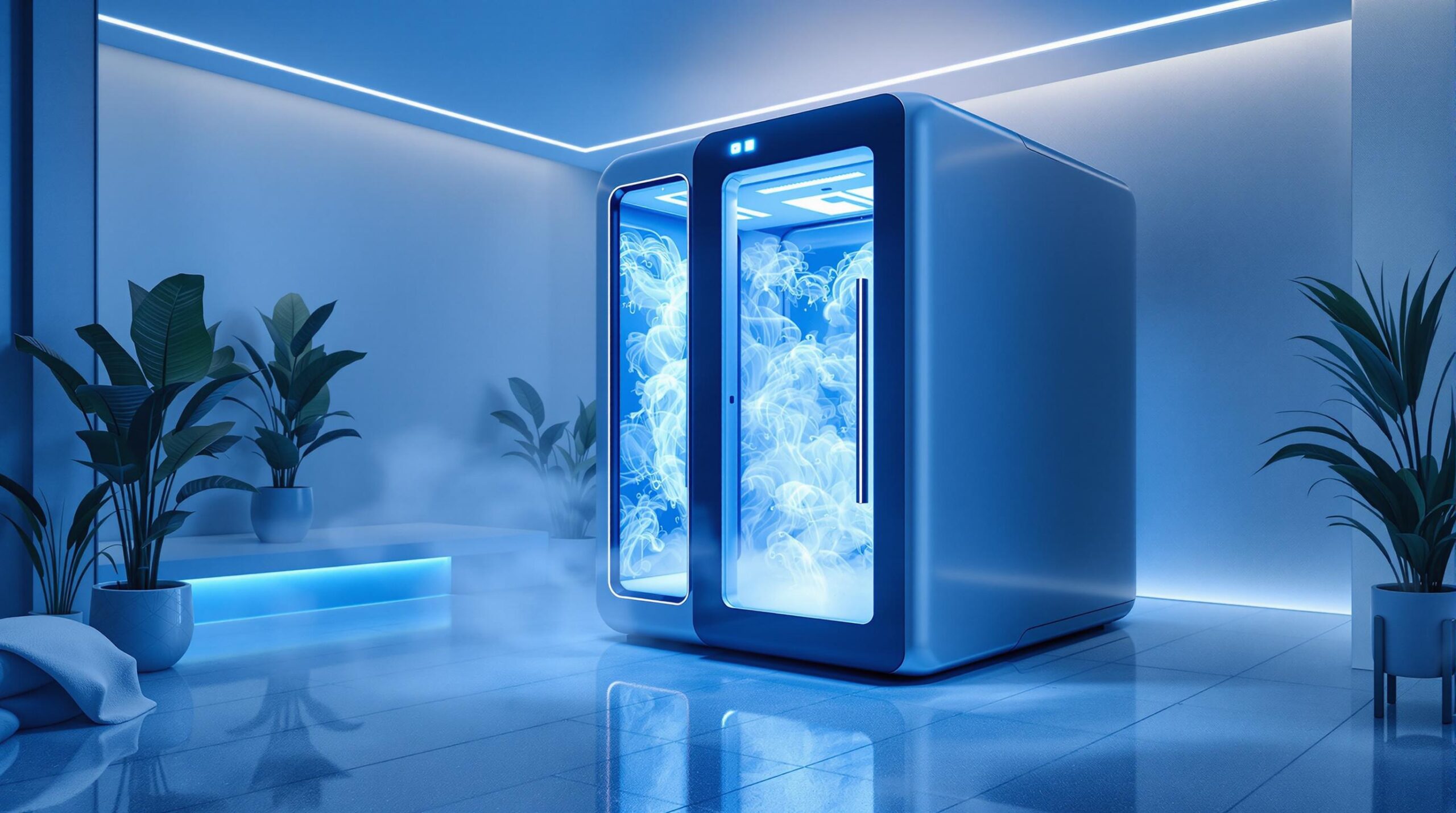Struggling with eczema or psoriasis? Whole Body Cryotherapy (WBC) might help. This treatment exposes your body to temperatures as low as -85°C, aiming to reduce inflammation, soothe itching, and improve skin health. Here’s what you need to know:
- How It Works: WBC triggers anti-inflammatory responses, improves blood flow, and calms overactive nerves, potentially easing symptoms like itching and redness.
- Benefits: Regular sessions may reduce dependence on steroids, improve sleep, and enhance skin hydration.
- Safety: Not suitable for conditions like Raynaud’s syndrome or cardiovascular issues. Always consult a professional before starting.
WBC could be a useful addition to your treatment plan, offering relief when combined with other therapies. Read on for the science, results, and guidelines.
The Science of Whole Body Cryotherapy
What Happens During Treatment
At The Cryo Hub Berkhamsted, Whole Body Cryotherapy (WBC) is performed in a state-of-the-art electric cryochamber that can reach temperatures as low as –85°C. During a 3-5 minute session, your entire body, including your face, is exposed to these extreme temperatures in a carefully controlled environment.
This rapid cooling causes vasoconstriction, where blood is redirected from your extremities to your vital organs to maintain core body temperature.
Full Body vs Partial Treatment Methods
When considering cold therapy, it’s important to understand the difference between full-body and partial treatments. The Cryo Hub’s electric cryochamber provides complete exposure, which is crucial for addressing inflammatory skin conditions effectively.
| Feature | Electric Whole Body Chamber | Partial Body Treatment |
|---|---|---|
| Coverage | Entire body, including face | Head remains outside |
| Air Quality | Fresh, oxygenated air | Exposure to nitrogen vapour |
| Temperature Control | Consistent and precise | Uneven temperature zones |
| Movement | Free movement allowed | Movement is restricted |
| Nerve Activation | Fully engages nervous system | Limited nerve response |
Body Responses to Extreme Cold
When exposed to –85°C, your body reacts in several ways:
"By rapidly cooling the skin the cold exposure in a cryo chamber causes the blood vessels in the skin and muscles to narrow… This leads to activation of the parasympathetic nervous system, the ‘rest and digest’ aspect of the nervous system." – Dr Hugh Coyne, Private GP Parsons Green
These reactions include:
- Reduced Inflammation: The cold helps lower levels of inflammatory chemicals such as histamine and cytokines.
- Improved Blood Flow: Post-treatment, blood vessels dilate, boosting circulation and aiding toxin removal.
- Nerve Response: The cooling effect soothes overactive nerve endings, helping to reduce itching.
These rapid changes in the body highlight why WBC is effective for easing symptoms of eczema and psoriasis.
Reducing Inflammation Through Cold Therapy
Effects on Inflammation Levels
Whole-Body Cryotherapy (WBC) at -85°C helps reduce inflammation by causing blood vessels to constrict, which limits the release of inflammatory substances. This targeted cold exposure can disrupt the inflammatory cycles often linked to skin conditions.
In addition to its immediate effects, WBC also bolsters the body’s natural ability to manage inflammation.
Supporting the Body’s Defences
Cold therapy enhances the body’s natural defence mechanisms through several biological responses. These processes contribute to managing inflammatory skin conditions over time:
| Response | Benefit |
|---|---|
| Circulatory Activation | Improved blood flow after treatment aids the body’s healing processes |
| Endorphin Release | Provides natural pain relief and reduces stress levels |
| Serotonin Production | Boosts mood and may help lower inflammation linked to anxiety |
| Nerve Calming | Helps soothe nerves, potentially reducing itching and other triggers |
Research from 2008 highlighted a "steroid-sparing" effect in eczema patients, indicating its potential as a complementary treatment option.
Benefits for Skin Health
By lowering inflammation and supporting the body’s defences, cold therapy contributes to healthier skin. Regular sessions can bring noticeable improvements. Patricia Cervini, an NEA Ambassador, shared her experience:
"In my experience with having eczema, cryotherapy definitely helped with both the itch and pain." – Patricia Cervini, NEA Ambassador
These benefits arise from WBC’s ability to reduce itching through nerve desensitisation, decrease skin inflammation with vasoconstriction, enhance sleep quality, and, in some cases, reduce dependence on topical steroids.
sbb-itb-32603e3
Research and Results
Eczema Treatment Studies
Clinical research highlights the potential of Whole Body Cryotherapy (WBC) in managing atopic dermatitis. In a pilot study led by Magdalena Kepinska-Szyszkowska, 14 adults with mild to moderate atopic dermatitis underwent 15 WBC sessions. The study assessed skin parameters such as hydration, sebum levels, and pH. Results showed improved skin hydration and a reduction in the SCORAD index, suggesting WBC may help as a supportive therapy for atopic dermatitis.
Psoriasis Treatment Results
Research into psoriasis treatment has also shown encouraging outcomes. A 1996 study examined WBC’s impact on small psoriasis plaques over 12 weeks. Of the 10 participants treated, the results were promising, while untreated control areas showed deterioration.
| Outcome (%) | Treatment Response |
|---|---|
| 50% | Complete Resolution |
| 20% | Significant Improvement (75–80%) |
| 10% | Partial Improvement (33%) |
| 10% | No Improvement |
Client Results and Feedback
Beyond clinical studies, individual experiences reinforce WBC’s benefits in managing skin conditions. For example, Bryson, a teenager struggling with persistent eczema flares, experienced noticeable improvements after undergoing localised cryotherapy three times a week for four weeks. For the first time in months, he was able to sleep through the night.
"Cryotherapy being a new form of rehabilitation in AD may supplement and support a long-term process of AD treatment, because it has anti-inflammatory and antipruritic effects and exerts a positive influence on the nervous system."
These findings highlight WBC’s potential as a complementary option for chronic skin conditions, particularly when used alongside a broader treatment plan. The documented results suggest its value in improving both symptoms and quality of life for individuals with eczema and psoriasis.
Treatment Guidelines
The following guidelines provide practical advice for safe and effective treatment.
WBC Treatment Schedule
Consistency plays a crucial role in managing eczema and psoriasis symptoms with Whole Body Cryotherapy (WBC). Research suggests that attending 2–3 sessions per week often delivers the best results.
Safety Information
Before starting WBC, it’s important to understand the safety guidelines and any conditions that might rule out its use. Dr J Hugh Coyne highlights:
"When performed in the appropriate setting with controlled conditions of temperature and humidity whole-body cryotherapy is a safe procedure. It has been shown to have no adverse effect on heart or lung function".
However, WBC is not suitable for everyone. Key medical conditions that prevent its use include:
| Medical Condition | Reason for Exclusion |
|---|---|
| Raynaud’s syndrome | Sensitivity to cold affects blood flow to extremities |
| Cryoglobinaemia | Cold-sensitive antibodies may block blood flow |
| Cardiovascular conditions | Constricted blood vessels could cause complications |
| Hypothyroidism | Increased sensitivity to cold |
| Acute respiratory disease | Cold air may aggravate symptoms |
Other exclusions include pregnancy, seizure disorders, and severe anaemia. Patients should have their blood pressure checked before each session and avoid alcohol or drugs beforehand, as these can interfere with the body’s natural reaction to cold exposure.
Ensuring safety is just one aspect. Integrating WBC into a broader treatment plan can help maximise its benefits.
Additional Treatment Options
WBC is often combined with other treatments to enhance its anti-inflammatory effects. Common pairings include:
- Traditional medications like cyclosporin or tacrolimus
- Stress management techniques, as reducing stress can positively impact skin health
Research also shows that WBC increases skin hydration immediately after treatment, with these effects lasting up to three weeks after the final session.
Summary
Whole-body cryotherapy (WBC) offers relief for eczema and psoriasis by reducing inflammation, easing itching, and alleviating pain. At The Cryo Hub Berkhamsted, the full-body cryochamber operates at -85°C, triggering a quick anti-inflammatory response. A 2020 pilot study found that WBC enhances skin hydration and lowers the severity of atopic dermatitis, as measured by the SCORAD index. These results highlight WBC as a helpful addition to standard treatments.
WBC can work alongside traditional medications and stress management strategies to create a well-rounded treatment plan. When used under professional guidance, its combined effects on inflammation, itching, and pain provide an effective option for managing chronic skin conditions. However, individual results depend on consistent use and adherence to treatment.







